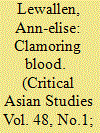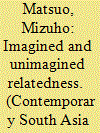|
|
|
Sort Order |
|
|
|
Items / Page
|
|
|
|
|
|
|
| Srl | Item |
| 1 |
ID:
143664


|
|
|
|
|
| Summary/Abstract |
The tension between silence and vocalization, embrace and rejection, of Ainu ancestry has been a key factor in negotiating Ainu subjectivity since Ainu territories were colonized in 1869. As early as 1799, expressions of Ainu ethnicity were alternately cloaked and exaggerated as Japan vacillated between assimilation and segregation policies in eastern Hokkaido Ainu communities. Officially recognized as Japan's indigenous peoples in 2008, Ainu subjectivity has become increasingly politicized as the state and other stakeholders seek to define Ainu ethnicity for future legislation. Today Ainu belonging is frequently gauged by bodily metaphors of a vocalized blood. Cultural sensibility and blood are often conflated in Ainu discourses of identity: Ainu revivalists report that a sensation of “clamoring blood” (J: chi ga sawagu) inspires them to revisit ancestral memories and begin fashioning Ainu identities. Historically, intra-Ainu relations were not bound to blood but instead embodied in material expressions, such as invisible cords for women and crest-like emblems for men, symbols that enabled flexibility where needed. Since the twentieth century, the hyper focus on blood raises the specter of colonially imposed rhetorics of eugenics, assimilation policies, and specifically, the problem of race. Relatedness in the Ainu community is not exclusively defined by “consanguineal relations”; rather, a long history of adopting ethnic Japanese children and non-Ainu into Ainu families renders complex the question of identity. This article assesses how immutable notions of racial difference intersect with self-determination and current articulations of Ainu identity.
|
|
|
|
|
|
|
|
|
|
|
|
|
|
|
|
| 2 |
ID:
178514


|
|
|
|
|
| Summary/Abstract |
This paper examines the ways in which egg donors, surrogate mothers, and intended parents in India imagine and unimagine their relationship with children born through third-party reproduction. Third-party reproduction is inseparable from plural parenthood and the question of who the ‘real’ parents are. In a legal and medical context, gestational surrogacy in India treats surrogates as not ‘real’ mothers, in favour of the ‘natural’ relationship between the intended mother and child. Here, the ‘genetic tie’ may ignore gestation in giving predominance to ‘genes’, but this logic is inverted in the case of egg donation, in which it is not uncommon for people to regard egg donors as ‘real’ mothers. Who is regarded as a ‘real’ parent, and who is not, is deeply embedded in the social process of creating kinship, shared notions of bodily substances, corporeal reality, and social recognition of ‘one’s own child’. The elements of gestation, genetic relations, and nurturing compete and coexist in the practice of third-party reproduction. This paper explores the multiple aspects of ‘real’ and ‘fictive’ kinship and its entanglement in making ‘a child of one’s own’ in third-party reproduction in India.
|
|
|
|
|
|
|
|
|
|
|
|
|
|
|
|
|
|
|
|
|